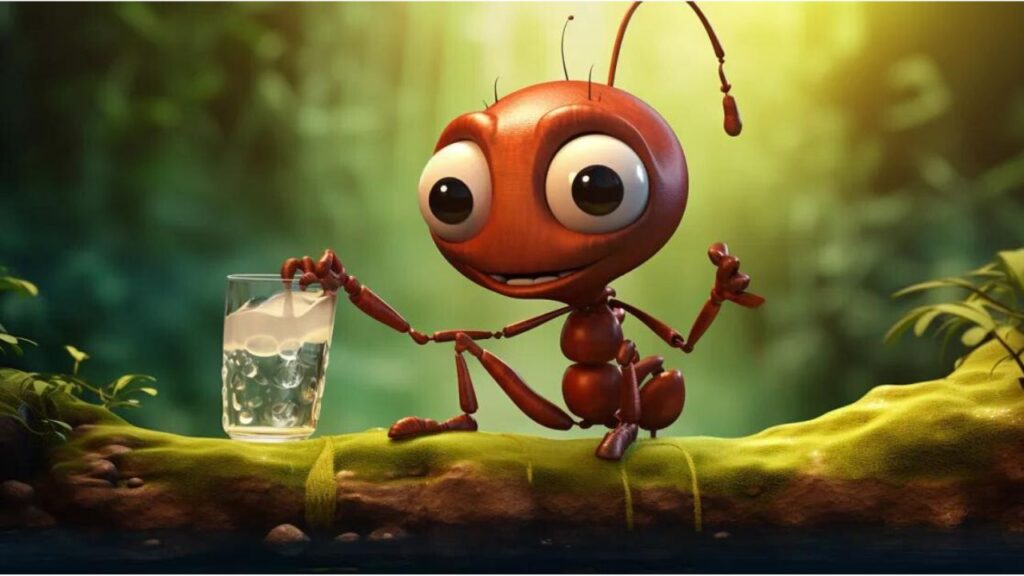The Function of the First Stomach: The Crop

Within the intricate societal framework of an ant colony, the crop plays a pivotal role in not only individual nutrition but also in the communal sharing of resources. This first stomach is a crucial element in the ant’s digestive system, serving purposes that go beyond simple digestion.
Role in Nutrient Absorption
Contrary to what one might expect, the crop is not significantly involved in the absorption of nutrients for the ant’s own needs. Instead, it acts primarily as a reservoir. The ingested food stored in the crop is in a pre-digestive state, held until it is either transferred to the second stomach for digestion or shared with other colony members. The crop’s ability to store food without absorbing it allows ants to carry more than their own nutritional requirements, enabling them to support their fellow colony members.
Mechanism of Food Storage
The crop’s structure is specialized for storage. It is an expandable part of the esophagus that can stretch to accommodate various amounts of liquid food. When an ant feeds, it uses its mandibles and mouthparts to ingest the nourishment, which then travels down to the crop. Here, the food can be kept for extended periods without degrading, as the crop has a slow rate of food passage and is adapted to prevent spoilage. This mechanism is essential for foraging ants, who often need to travel considerable distances to collect and transport food back to the nest.
Social Implications of the Crop
The social stomach, or crop, is the heart of the ant’s communal lifestyle. Through a process known as trophallaxis, ants can regurgitate the contents of their crop to feed other ants that cannot or do not leave the nest, such as the queen, larvae, or workers assigned to tasks within the nest. This sharing of food reinforces the social bonds within the colony and ensures the survival of its members, especially those that are vital to the colony’s reproduction and maintenance. Trophallaxis also plays a role in the dissemination of pheromones and hormones that help maintain the colony’s social structure and communication.
The crop’s function is a beautiful example of how ants have evolved to become one of the most socially integrated species on Earth. It is a testament to the power of collective effort and altruism, ensuring that no ant within the colony goes without nourishment, and solidifying the crop’s role as a cornerstone of ant society.
The Function of the Second Stomach: The Gaster

The second stomach of an ant, known as the gaster, is where the alchemy of digestion truly occurs. This posterior part of the digestive system is vital for the individual ant’s sustenance, turning ingested matter into energy and ensuring the continuation of the ant’s life cycle.
Digestion and Energy Conversion
The gaster’s primary function is the digestion of solid food particles and the conversion of them into usable energy. Once food has been deemed unnecessary for social storage, it moves from the crop into the gaster. Here, digestive enzymes break down the food, nutrients are absorbed, and energy is extracted. This energy fuels the ant’s activities, from foraging and excavating to caring for the young and defending the colony. The gaster is an efficient digestive machine, designed to extract maximum value from the food it processes.
Waste Management
After the gaster has extracted the nutrients, the remaining undigested waste moves into the hindgut for excretion. The ant’s waste management system is a model of efficiency, dealing with solid waste and ensuring that the ant’s body is cleared of by-products that could be harmful if accumulated. This system also plays a role in maintaining the cleanliness of the colony, as ants are meticulous about waste disposal, often designating specific areas far from the nest for this purpose.
The Role in Feeding Larvae
The gaster is not solely about serving the needs of the individual ant; it also has a role in the collective nourishment of the colony’s young. When larvae require solid food to progress in their development, it is the responsibility of the worker ants to provide it. They partially digest the solid food in their gaster, then regurgitate it in a form that is palatable and nutritious for the larvae. This process ensures that the larvae receive the proper balance of nutrients to grow and eventually metamorphose into adult ants, perpetuating the colony’s life cycle.
The gaster’s role in digestion, energy conversion, waste management, and feeding the young encapsulates the essence of the ant’s biological success. It is a testament to the evolutionary refinement of ants, showcasing a specialized organ that not only supports the individual’s survival but also underpins the health and future of the entire colony.
Foraging and Food Distribution

In the complex society of ants, foraging is more than a survival act; it’s a choreographed ballet that sustains the colony. The foragers, the gatherers, are the backbone of this system, ensuring that no member of the colony goes hungry. This section examines the pivotal role of the forager, the intimate act of sharing food through trophallaxis, and the strategic selection and collection of food resources.
The Forager’s Role
Forager ants are the adventurers of the colony, embarking on expeditions to scout and collect food. Their role is critical—they must brave the outside world, navigate to food sources, assess their quality, and transport sustenance back to the nest. Equipped with their two-stomach system, foragers store liquid food in their crops, keeping it from mixing with their own digestive enzymes so that it can be shared with other colony members. Their ability to communicate the location of food through pheromone trails enables other foragers to assist in the harvesting process, exemplifying the collective effort in food acquisition.
Sharing Liquid Food: Trophallaxis
Trophallaxis, the transfer of food from one ant to another, is a hallmark of the ant colony’s cooperative nature. This mouth-to-mouth (or, more accurately, mouth-to-abdomen) feeding allows the nutrients stored in the crop of foraging ants to be directly shared with other members of the colony. This process is not merely about nutrition; it also serves as a social interaction, strengthening the bonds within the colony and disseminating chemical signals that regulate social organization and behavior. Trophallaxis ensures that every member of the colony, from the queen to the youngest larvae, receives the nourishment needed to fulfill their roles.
Food Selection and Collection Strategies
Ants exhibit a sophisticated approach to selecting and collecting food. They do not gather sustenance randomly; instead, they employ strategies that maximize efficiency and nutritional return. Foragers typically prioritize high-energy food sources, such as sugars and proteins, which are essential for the colony’s growth and survival. They also adjust their foraging patterns based on the colony’s current needs, which can change with the seasons, the developmental stage of the colony, or the presence of competing colonies. By using a combination of individual experience and chemical signals from the colony, foragers can determine the best times to forage and the best types of food to collect.
The system of foraging and food distribution in ants is a marvel of social organization, one that showcases the intersection of individual initiative and collective welfare. The foragers, with their critical role in food collection, and the practice of trophallaxis, with its implications for colony health and social structure, are prime examples of how ants have evolved not just to survive, but to thrive through unity and cooperation.
Colony Health and the Two-Stomach System

The health of an ant colony is intricately linked to the functionality of the two-stomach system, a dual mechanism that not only facilitates nourishment but also underpins the collective well-being and resilience of the community.
Disease Prevention and Health Checks
One of the most critical aspects of colony health is disease prevention, and the two-stomach system plays a pivotal role in this regard. The social stomach or crop acts as a first checkpoint for ingested materials. Ants have the ability to detect and neutralize potentially harmful substances before they reach the true stomach or gaster, which is vital for individual ants’ health. The crop can act as a quarantine zone, preventing the spread of pathogens throughout the colony. Moreover, during trophallaxis, ants exchange not just food but also gut microbiota, which can enhance the colony’s disease resistance by maintaining a robust and diverse microbial community.
The Impact on Colony Nutrition
The two-stomach system is central to the nutritional management within the ant colony. The crop allows foragers to bring back more food than they need for themselves, which can then be distributed based on the colony’s demands. This ensures that all members, especially those critical to reproduction and brood care, like the queen and larvae, receive adequate nutrition. By acting as communal storage units, the foragers can regulate the flow of food within the colony, maintaining a steady supply even when external resources are scarce.
Longevity and Survival Strategies
The longevity and survival of an ant colony hinge on its ability to efficiently manage resources, a task at which the two-stomach system excels. During times of plenty, ants can store excess food in their crops, which can be a lifesaver during lean periods. This system also allows the colony to exploit food sources that may be available sporadically and at a distance from the nest. By enabling a flexible response to food availability, the two-stomach system supports complex survival strategies that have allowed ant colonies to thrive in unpredictable environments and become one of the most successful groups of organisms on Earth.
The two-stomach system is a linchpin in the complex machinery that keeps an ant colony healthy and robust. It is a brilliant evolutionary solution to the challenges of communal living, enabling ants to prevent disease, manage nutrition, and devise strategies for long-term survival. This system reflects the profound interconnectedness of ants, where each individual’s health is inextricably linked to the colony’s overall vitality.
Ants’ Stomachs and Human Implications

The intricate design of ants’ dual stomachs offers more than just a window into their world; it provides insights that can influence human practices, agriculture, and even biomedical research. Let’s explore the relevance of ants’ digestive adaptations to our human endeavors.
Insights for Human Food Sharing Practices
The study of ants’ food sharing practices, particularly the role of the crop in nutrient distribution, can offer valuable lessons for human societies. Ants exemplify the benefits of a communal approach to food resources, ensuring that all members of the community are nourished and capable of contributing to their collective goals. This model of resource distribution has implications for human food sharing systems, encouraging us to consider how our practices can be more inclusive and efficient. It also prompts us to reflect on the importance of food security and the potential for creating systems where waste is minimized and every member has access to the nutrition they need.
Agricultural and Ecosystem Implications
Ants play a significant role in agriculture and ecosystems through their foraging activities and soil interaction. Their two-stomach system, especially their method of collecting and dispersing seeds, can aid in plant propagation and biodiversity. Understanding how ants select and distribute seeds can inform agricultural practices, potentially leading to more effective methods of crop rotation and soil health management. Additionally, the role of ants in aerating soil and recycling nutrients highlights their importance in maintaining healthy ecosystems, which can guide sustainable farming and conservation efforts.
Potential for Biomedical Research
The ant’s crop is a model of a natural sterile compartment, offering intriguing possibilities for biomedical research. The mechanisms ants use to prevent the spread of pathogens within their colonies could inspire the development of new antibiotics or sterilization techniques. Furthermore, the study of ants’ microbiota, exchanged during trophallaxis and essential for their health, can contribute to our understanding of human gut bacteria and its impact on health and disease.
The ants’ stomachs, with their dual functionality, open up a myriad of implications for human society, agriculture, and medicine. They serve as a blueprint for efficient resource sharing, a catalyst for ecological balance, and a potential treasure trove for medical science. As we continue to learn from these tiny creatures, we find that their influence extends far beyond the soil they tread, reaching into aspects of human life and well-being.










